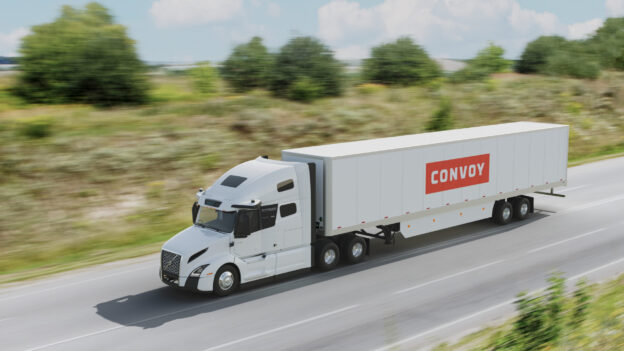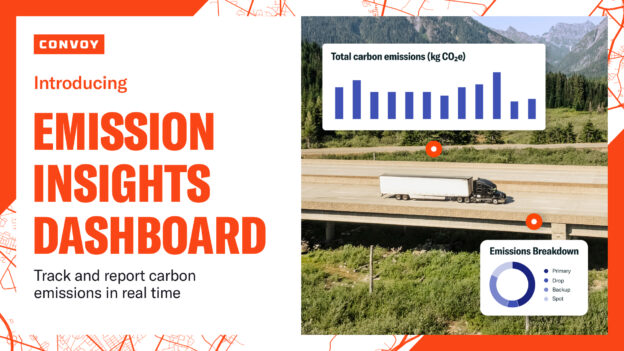What to do when a shipment is rejected
Sustainability • Published on August 27, 2020
Often when a shipment is rejected at the receiver it causes lost time, additional fuel costs and wasted products. From a sustainability perspective, this can negate prior cost savings and fuel efficiency. Carriers end up losing out on their next shipments, spending more in fuel for reroutes and the disposition process can hold up their truck for weeks in some cases. From the shipper’s perspective, product rejections can incur additional shipping costs and waste entire truckloads of product, and even strain the relationship with a customer. In this post, I’ll dive into the implications of each type of disposition and the environmental and financial impacts for carriers and shippers involved.
It all starts with the disposition
Disposition is a term used to describe the direction and instruction provided by the shipper or customer when product is rejected at delivery. Convoy waits for disposition from the shipper when there is a shortage, overage or product damage is discovered.
There are a few directions a receiver can take if there are issues with the product. If there is too little or excess product that wasn’t ordered, shippers will typically reimburse their customers with credit toward future orders or send the corrected amount of product in a future shipment. If a few pallets of product were damaged in transit or upon loading, this can cause a complete or partial rejection at the delivery facility and it is the carrier’s responsibility to report and hold onto any additional or damaged product. If product is not unloaded, there are three ways a product refusal can go:
- reworking with a third party and disposal by the carrier or facility
- reroute to a different facility
- disposal by the carrier, or
- donation by the carrier.
For companies looking to prioritize a triple bottom line, it’s important to plan ahead in case shipments aren’t successfully delivered. The environmental impact of shipment rejections can overturn any efforts for efficiency into waste in a matter of hours.
Product Shortage
A product shortage often originates at the shipping facility. It’s possible that the shipper didn’t produce enough that day or the crew simply loaded the trailer incorrectly. For carriers, waiting for direction typically doesn’t take as long as a product overage or damage would. This is because the receiving facility will notify the shipper to receive a credit or additional product in a future order. Shortages typically have limited downstream impact as the customer can receive product at a later time. An efficient method would be to fill a lighter shipment with the missing product. The downside for shippers and their customers is that projected sales will likely be impacted if the receiver is out of stock. This can potentially interfere with the receiver’s inventory plans and negatively impact their relationship with the shipper if it becomes a repeat issue.
Product Overage
When excess product is mistakenly loaded that was not ordered by the receiving facility, two things can happen:
- the receiver can accept the additional pallets and the shipper will bill for it later
- they will place the excess product back on the driver’s trailer.
If unloading the extra product isn’t a viable option for receiving facilities, shippers can then decide on the following:
- reroute back to the pickup facility or another facility
- disposal
- donation
If additional product is unloaded at the receiver, this can be a smoother process for carriers as they are able to get paid out and do not have to keep product for an extended period of time. Unfortunately, not all receiving facilities have room in the warehouse to store excess product.
In the case of an overage, the least ideal methods are disposal and reroute. To send the product back to the shipping facility, shippers will typically incur the cost of fuel for the round trip to the receiver and back to the pickup facility. While disposal and donation may be more simple than coordinating the reverse logistics of a reroute, the downside for shippers is they typically lose out on profits from the unused product.
Reworking and Redelivering
Typically when pallets have shifted in transit, a few things need to happen before the shipment can be unloaded. First, the shipment will need to be restacked either onsite or at a facility that can rework the pallets so the original receiver can safely unload the truck. Oftentimes, there is one pallet or less of product deemed unsalvageable. The shipper’s quality and claims teams will determine which pallets need to be disposed of or donated and which can be redelivered to the receiving facility. Unfortunately, this process can take more than a day for shippers to determine which products meet quality standards.
The benefit of reworking a shifted shipment is that at least part of the order can still be utilized by the delivery facility. Reworking and redelivering a load can still be wasteful since it takes the carrier additional miles to go out of the way to a lumper facility and back to the delivery facility, not to mention that at least a few cases of product may not be salvageable even after restacking.
Lumpers are hired specifically to restack shipments and may not be allowed onsite by the facility or may not have enough staff to dispatch out to a receiving facility. Sourcing a lumper nearby can take days and use up the carrier’s fuel in order for the shipment to be reworked offsite. Lumper fees can range from a partial restack at $100-1,000 to a full truckload ranging from $1,500 – 5,000.
Regardless of fault, these fees are more commonly reimbursed by the shipper upfront, in addition to out of route miles, layovers for waiting time, and storage fees which is typically less than the cost of a full product loss, such as disposal.
Donation
In the case that a shipment is not up to the customer’s standards, it is still possible to reuse products through local truckload donations. This can be scheduled by the carrier once approved by the shipper, although there are still high standards for products to be donated. For instance, food and beverage products must be safe enough to consume and retail products must be lightly used and functional.
Donations are optimal to work toward a more circular economy so that products can be utilized and shippers can receive tax credits for their donations. Although similar to disposals, shippers can still lose out on product that was not delivered to their customers.
Donating rejected shipments primarily benefits shippers. It can be burdensome for carriers to find a donation facility with enough space for partial or full truck load donations. If the shipment doesn’t qualify for Convoy’s Feeding America program, it can take more than a day to schedule donations which can hold up carriers’ trucks longer. It is possible that carriers may spend more in fuel to find a donation facility as they can be farther from their route than a general disposal facility. Scheduling a donation can be just as detrimental to a carrier’s business as disposal; both options generally mean lost jobs and more fuel consumption if the facility is not near a well populated area.
One successful donation initiative is Convoy’s partnership with Feeding America, as there is typically a donation site within about 40 miles of the carrier. In this instance, donating food and beverage can be a more efficient and cost effective option for carriers as it will take less fuel to reach a nearby Feeding America facility.

Disposal
When goods are determined to be unsalvageable they are typically consigned to dump. Although the previously mentioned options are better for the environment, disposals are often necessary at times. While it would be ideal to recycle and reuse rejected shipments, it is often not feasible due to compliance with quality and safety standards.
One of the only benefits to partial or full disposals is the quick turnaround for scheduling compared to scheduling donations or rerouting to a different facility. Liability is the biggest reason why disposal can be non-negotiable at times, and why it’s important for shippers to keep their claims and quality teams involved in the disposition process.
Disposing of product can be difficult for carriers since they must hold product until they are able to find a disposal site and often pay out of pocket disposal fees, averaging from free up to around $1,500 for a partial truckload and up to $10,000 or more for full truckloads. Carriers are typically only paid for the time spent until their truck is empty, which means more than likely their disposal fee can outweigh their payment for wait time. Disposals can take longer to schedule if a shipper uses a facility with more sustainable methods, reducing their harm to the environment compared to traditional landfills. For carriers working with Convoy, it’s easier to recover from wasted time by instantly booking reloads.

In general, rejected shipments can be costly for both the carrier, shipper, receivers, and the environment. Disposition can vary depending on product cost, type and customer demands. In all cases except for a shortage, carriers can expect to be delayed on their next shipment and spend up to double the amount of fuel that they were originally expecting to use.
If a carrier drives 40 to 250 miles out of the way to the nearest lumper, shipping facility, or disposal facility, this could cost them between $50 to $1,300 in fuel.
Due to the delicacy and variety of situations, disposition can take days or weeks to schedule and coordinate; increasing the cost for the shipper. Keeping carriers’ trucks full while waiting for direction can cause carriers to lose out on additional loads that would have maximized their route, originally eliminating their empty miles.
Although disposal can be quicker and at times less expensive, wasted product can negate a shipper’s efforts to reduce waste while reducing transportation costs. Although neither disposition is ideal, there is room for improvement and partnerships in the future that make it ideal to reuse and recycle safely.



